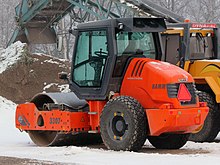In geotechnical engineering, soil compaction is the process in which stress applied to a soil causes densification as air is displaced from the pores between the soil grains. When stress is applied that causes densification due to water (or other liquid) being displaced from between the soil grains, then consolidation, not compaction, has occurred. Normally, compaction is the result of heavy machinery compressing the soil, but it can also occur due to the passage of, for example, animal feet.
In soil science and agronomy, soil compaction is usually a combination of both engineering compaction and consolidation, so may occur due to a lack of water in the soil, the applied stress being internal suction due to water evaporation[1] as well as due to passage of animal feet. Affected soils become less able to absorb rainfall, thus increasing runoff and erosion. Plants have difficulty in compacted soil because the mineral grains are pressed together, leaving little space for air and water, which are essential for root growth. Burrowing animals also find it a hostile environment, because the denser soil is more difficult to penetrate. The ability of a soil to recover from this type of compaction depends on climate, mineralogy and fauna. Soils with high shrink–swell capacity, such as vertisols, recover quickly from compaction where moisture conditions are variable (dry spells shrink the soil, causing it to crack). But clays such as kaolinite, which do not crack as they dry, cannot recover from compaction on their own unless they host ground-dwelling animals such as earthworms—the Cecil soil series is an example.
Before soils can be compacted in the field, some laboratory tests are required to determine their engineering properties. Among various properties, the maximum dry density and the optimum moisture content are vital and specify the required density to be compacted in the field.[2]




- ^ Soil compaction due to lack of water in soil
- ^ Jia, Xiaoyang; Hu, Wei; Polaczyk, Pawel; Gong, Hongren; Huang, Baoshan (2019). "Comparative Evaluation of Compacting Process for Base Materials using Lab Compaction Methods". Transportation Research Record: Journal of the Transportation Research Board. 2673 (4): 558–567. doi:10.1177/0361198119837953. ISSN 0361-1981.